Owning property is a huge step one takes, financially and emotionally. Thus, when embarking on such a journey, it is always important to make sure you have everything you need.
You will need documents from the seller, government, housing board, etc. This article brings you a legal checklist for purchasing a property in India.
Documents You Should Have Before Buying
In this article
1. Documents Required Before Buying A Plot
- Sale Deed
- Encumbrance Certificate
- RTC
- Khata certificate and extracts
- Tax paid receipts
- Conversion order (if any)
- Layout plan (if any)
- Allotment Letter (if any)
2. Documents Required Before Buying An Apartment
- Title Deed
- Encumbrance Certificate
- Katha and Mutation Records
- Approved Building Sanction Plan
- Building Completion Certificate
- Occupancy Certificate
- Last paid tax receipts
- RTC
- NoCs from government departments
- NoCs from Local Authorities
- Utility Bills (if any)
3. Documents Required Before Buying An Independent House
- Sale Deed
- Encumbrance Certificate
- Khata and Mutation Records
- Approved Building Sanction Plan
- Occupancy Certificate
- Last paid tax receipts
- RTC
- Plot Allotment Letter (if any)
- Approved Layout Plan (if any)
- Utility Bills (if any)
Legal Checklist For Property Purchase
Following is the checklist of important property documents in India:
1. Title Deed And Sale Deed
Title Deed is the legal document that establishes proof of ownership of the property. It also confirms that all terms and obligations agreed upon are met. This document is a mandatory document for both purchase of property and home loan. The presentation of this certificate must be in its original form.
Execution of title deed takes place after the sale agreement. Registering the document is necessary to make it valid under Registration Act, 1908. The nearest Sub Registrar Office to the property registers the certificate. You must file for this deed within 4 months of execution. If not, you have to pay the penalty; otherwise, it is invalid.
A Sale Deedshows the transfer of ownership of the property from one person to the other. It shows the agreement; the buyer has agreed to buy the property from the seller. This includes the details of both the buyer and the seller. Both are also required to sign on every page of the Deed. A Sale Deed becomes a Title Deed when registered.
If many people owned the property, then it is important to check all the Link Deeds. In cases like this, obtaining the Mother Deed also becomes necessary. This parent document acts as the main document to prove ownership. While tracing the ownership, the suggested method is to start with the Mother Deed. Follow this up by linking all the other older deeds until you reach the latest one. This latest deed should be in the name of the seller.
Linking all the previous owners helps you see if there are any disputes on property ownership. Thus, ensuring if the owner is the actual owner of the property or not. Sometimes, the owner only has developmental rights and not ownership.
An example of a Sale Deed is:

2. Encumbrance Certificate
This, along with Title Deed, is one of the most important documents related to owning a property. This certificate ensures that the owner has complete ownership. It essentially is evidence that the property has free ownership. This document is also proof that the property is free from any kind of monetary or legal problems.
It contains information on all transactions done on the property. If the property is gifted or inherited, the EC will reflect this. This certificate is mandatory while applying for a house loan.
To avail of this certificate, fill out Form 22, available online for all states. Submit this form and a photocopy of the title deed to the nearest Sub Registrar’s Office. The office issues Form 15 if there are outstanding dues. If there are no dues, then Form 16.
An example of an Encumbrance Certificate is
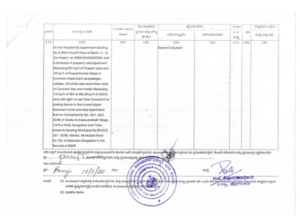
3. Khata
Khata is an account of anyone who is the owner of a property in a particular city. It is an entry in the record of your municipal committee.
There are two types of Khata; certificate and extract.
i. Khata Certificate
Registration of new property and transfer of property is through this certificate. It is necessary when applying for a building license or a trade license. It is impossible to get water or an electricity connection without this certificate. Also, banks do not issue a home loan without this. These things make this certificate mandatory for the owner. It is always shown in its original form only.
The Assistant Revenue Officer of the locality has the jurisdiction to grant one. The Officer issues the certificate, which states the property number as well as the owner’s name. It is only granted to the owner.
ii. Khata Extract
This document contains all the details of the property from the assessment register. This Extract gives the following details about the property.
- Name and size of the property
- Use of the property (residential or commercial)
- The annual value of the property
- Date of the last assessment
An example of a Khata is:
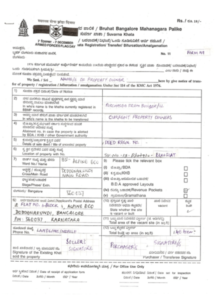
4. Mutation Register Extracts
Although not a legally binding document, this is very important and useful. It shows the transfer of property in official records of the Municipal or Tax Department. The main reason one gets this document is to pay the property tax. You will require mutation documents If you want to sell or gift your property.
This document also gives the following details.
- Details on the previous owner
- Details on present owner
- Mode of acquisition
- The extent of the property
It also contains an order to transfer the Khata of the property to the present owner. This detail makes this an important document, but it is not mandatory.
An example of Mutation Register Extracts is:

5. Joint Development Agreement
This document is an agreement between an individual landowner and a builder. The landowner contributes to the land, and the builder contributes to the development process. The joint development ratio depends on the land price, in most cases.
Usually, the builder allows a certain number of flats to the landowner. Thus no exchange of money takes place. For this, the landowner makes the builder his nominee or gives him a share of the land.
This document is important to establish who is the original owner of the property. Thus, it is a mandatory document to have.
A sample of JDA is
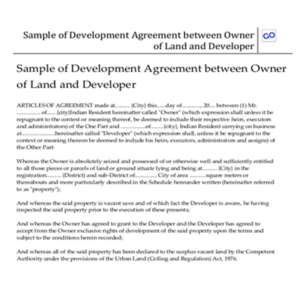
6. Building Plan Sanctioned
This makes sure that the building’s construction complies with the approved plan. The local sanctioning authority, like the Municipality office, approves it. The developer must apply for a “building completion certificate.” The authorities will see if the building meets some standards. These include how far away it is from the road, the building’s height, and a water harvesting system.
7. Housing Plan Approval
This document ensures that the locality is safe. It shows if there is a violation of the building by-laws. The layout of the building should abide by the rules of the National Building Code of India. It should also comply with the Green Rating for Integrated Habitat Assessment.
8. NOCs
The builder requires a no-objection certificate from 19 government departments. These include the electricity department, Water Works, Fire & Safety, Pollution Control Board.
Without all the NOCs in place, the builder will have to rely on other sources to make ends meet. This can amp up the price.
These NOCs are very important to ensure that all government approvals are in place. This ensures the safety and health of all the occupants of the house.
The importance justifies its compulsion. This should be in the original form.
9. Possession Certificate
It states the date of possession of the property. The developer must issue this certificate. He can do so after receiving a “completion certificate” from the concerned authorities.
This certificate details the date of the last payment and the date of possession. This certificate is a must while securing a home loan.
10. Occupancy Certificate
Local authorities issue this after ensuring the builder followed all rules and regulations. They check if the building is safe for the inhabitants.
This is an essential certificate to ask the builder for. If he fails to provide one, it can lead to problems in the future. The buyer has the authority to file an RTI inquiry to check the builder ever applied for an OC or no.
An example of OC is-
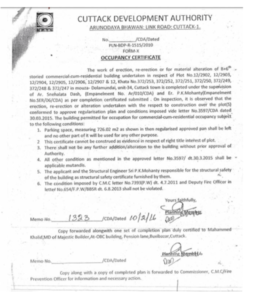
11. Allotment Letter From The Housing Board
This certificate is important to avail of a bank loan. The Housing Board writes a letter to the bank detailing the amount the buyer has paid. Based on this, the bank issues a home loan to finance the remaining amount.
12. The Latest Tax Paid Receipts
Income generated from properties comes under the Income Tax Act. As a result, it is mandatory to pay taxes on your property. It is important to ensure that all previous taxes are paid. Any outstanding payments can be a red flag. To verify this, ask for the latest tax paid receipt. It also helps check if the previous owner was responsible.
13. Latest Electricity Bill And The Receipt
Electricity Bill can help you establish proof of ownership too. Thus, you should always ask the previous owner for the receipt of the last paid electricity bill.
14. RTC (Record Of Rights, Tenancy And Crops)
This document establishes the Title of Land. It establishes whether the property is converted or not. A converted land is agricultural land that is now non-agricultural. The Village Accountant issues it. It is not a mandatory document. Presenting this document in its original form is not important. Yet, you do need a copy of the document when buying the property.
Its contents include-
- Surve or sub-survey number of the land
- Kharab land
- Names of all the owners, present and previous
- Names of tenants
- Mortgages
- Any charges made on the property
- Mutation references
- Inheritance certificates
- Kind of soil and the crop(s) grown.
- Status of the land (converted or not converted)
If it is a converted land, then the RTC will include the following details.
- Conversion order number
- Conversion date of the property
An example of RTC is
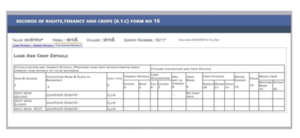
15. General Power Of Attorney
This is an authority that the owner gives to a person. This makes the person their legal representative. This allows them to take legal and financial decisions on their behalf. This includes buying and selling properties.
This document is important as it helps prove that the GPA made the previous sale or not. It is a mandatory document that should be in its original form.
Some Other Things To Look Out For A While Before Buying Property
i. Antecedents Of The Seller
It is important to check the character and antecedents of the seller. If the seller is a real estate offender, it is better not to continue with them. This will help your property purchasing process to be smooth.
ii. Inspection Of Property
It is important to check the title, ownership, and possession of the property. Talking to the neighbors about any ongoing disputes is helpful. You can bring in a land surveyor to know the exact boundary.
iii. Real Estate Regulation & Development Act (Rera)Approval
Getting a RERA approval means that the building is complicit with the Act. It is the buyer’s responsibility to see if the property is registered under RERA. This allows the buyer to see any complaints against or defaults by the seller. This helps the buyer check the seller’s credibility.
iv. GST Compliant
If the builder is charging GST on payments, then ask for the payment receipts with GSTIN.
v. Housing Board Documents
Allotment Letter and NoCs from the Housing Board or Society is important.
vi. Mortgaged Property
It is important to check if the property has a mortgage or a loan on it. Ask the seller for the Release Deed or a NOC from the bank.
vii. Property Valuation
A smart buyer should check the neighboring properties’ valuation to see if he is getting a good price. Information from Sub-Registrar Offices and Real Estate Agents can also help.
Frequently Asked Questions (FAQ)
1. What are the benefits of finding all the Link Deeds?
Finding details of previous owners and their ownership can be very beneficial. It can help you uncover any problems with the property that may have occurred over time.
2. Does the current property owner need to know that I am searching for all the Link Deeds?
No, The information on the previous owner’s ownership is available through government documents. Thus, there is no need to notify the current owner about this.
3. Is my title deed my proof of ownership?
No, Your title deed shows that a transfer of ownership has taken place. It depicts that you have bought whatever rights the previous owner had on the property. It fails to show if any others, too, had some rights in the property.
4. What is the difference between mutation and registration?
Registration is the shift of ownership from the buyer to the seller. The mutation is a process carried out after registration. It notifies the concerned authorities that you are the new owner of the property.
5. Does a possession letter make the buyer the legal owner of the property?
No, A possession letter does not. For that, the buyer must have an occupancy certificate.
6. What is the difference between an occupancy certificate and a completion certificate?
A completion certificate ensures that the building is complicit to the approved plans. An occupancy certificate ensures that the building obeys the building standards. It ensures that the building is safe to occupy and obeys the local laws.
Collecting all the required documents for your property purchase is essential. This can help you in case of an emergency or the future if you choose to sell the property. This article has all the information on the documents you will need.


Leave a Reply